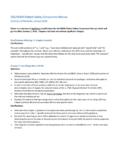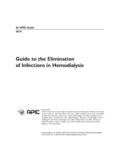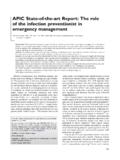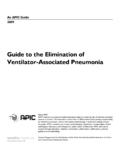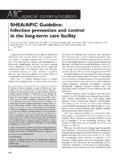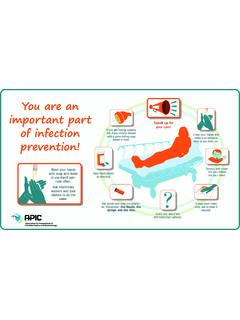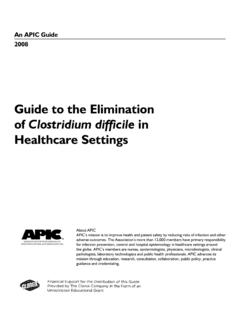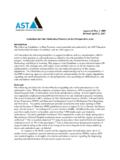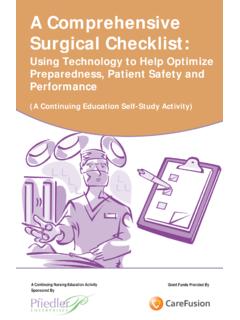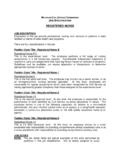Transcription of Guide to the Elimination of Orthopedic Surgical Site ...
1 An APIC Guide 2010. Guide to the Elimination of Orthopedic Surgical Site Infections About APIC. APIC's mission is to improve health and patient safety by reducing risks of infection and other adverse outcomes. The Association's more than 13,000 members have primary responsibility for infection prevention, control, and hospital epidemiology in healthcare settings around the globe. APIC's members are nurses, epidemiologists, physicians, microbiologists, clinical pathologists, laboratory technologists, and public health professionals. APIC advances its mission through education, research, consultation, collaboration, public policy, practice guidance, and credentialing The Association of periOperative Registered Nurses (AORN) is the national association committed to improving patient safety in the Surgical setting. AORN's mission is to promote safety and optimal outcomes for patients undergoing operative and other invasive procedures by providing practice support and professional development opportunities to perioperative nurses.
2 AORN is the premier resource for perioperative nurses, advancing the profession and the professional with valuable guidance as well as networking and resource-sharing opportunities. AORN is recognized as an authority for safe operating room practices and a definitive source for information and guiding principles that support day-to-day perioperative nursing practice. The printing and distribution of this Guide was sponsored by 3M. APIC is solely responsible for the content of this Guide . For additional resources, please visit Look for other topics in APIC's Elimination Guide Series, including: Acinetobacter baumannii Catheter-Associated Urinary Tract Infections Clostridium difficile CRBSIs Hemodialysis Mediastinitis MRSA in Hospital Settings, 1st edition MRSA in Hospital Settings, 2nd edition MRSA in Long-Term Care Ventilator-Associated Pneumonia Copyright 2010 by APIC. All rights reserved. No part of this publication may be reproduced, stored in a retrieval system, or transmitted, in any form or by any means, electronic, mechanical, photocopying, recording, or otherwise, without prior written permission of the publisher.
3 All inquires about this document or other APIC products and services may be addressed to: APIC Headquarters 1275 K Street, NW. Suite 1000. Washington, DC 20005. Phone: Email: Web: Disclaimer APIC provides information and services as a benefit to both APIC members and the general public. The material presented in this Guide has been prepared in accordance with generally recognized infection prevention principles and practices and is for general information only. The Guide and the information and materials contained therein are provided AS IS , and APIC makes no representation or warranty of any kind, whether express or implied, including but not limited to, warranties of merchantability, noninfringement, or fitness,or concerning the accuracy, completeness, suitability, or utility of any information, apparatus, product, or process discussed in this resource, and assumes no liability therefore. On the Cover: Cover image courtesy of CDC/ Jeff Hageman, Photo Credit: Janice Haney Carr, 2005.
4 This 2005 scanning electron micrograph (SEM) depicted numerous clumps of methicillin-resistant Staphylococcus aureus bacteria, commonly referred to by the acronym, MRSA; Magnified 2381x. Recently recognized outbreaks, or clusters of MRSA in community settings have been associated with strains that have some unique microbiologic and genetic properties, compared with the traditional hospital-based MRSA strains, which suggests some biologic properties, , virulence factors like toxins, may allow the community strains to spread more easily, or cause more skin disease. A common strain named USA300-0114 has caused many such outbreaks in the United States. See PHIL 7823 for a black and white version of this micrograph. ISBN: 1-933013-50-8. Guide to the Elimination of Orthopedic Surgical Site Infections Table of Contents Acknowledgements.. 4. Guide Overview .. 6. Background.. 7. Incidence, Scope & Epidemiology .. 9. Pathogenesis .. 13.
5 Surgical Wound Definitions and Diagnosis .. 17. The Infection Prevention Program .. 20. Surveillance.. 24. Outcome Reports .. 30. Surgical Care Improvement Project (SCIP) & CMS Value-Based Purchasing .. 33. Preoperative Preparation.. 38. The Perioperative Setting .. 41. The Postoperative Period.. 52. Future Trends .. 54. Lessons Learned.. 55. References.. 56. Appendices .. 65. 3. Guide to the Elimination of Orthopedic Surgical Site Infections Acknowledgements APIC acknowledges the valuable contributions of the following individuals: Authors Linda R. Greene, RN, MPS, CIC. Director Infection Prevention and Control, Rochester General Health System, Rochester, NY. Regina Mills, RN, BSN, CNOR. Charge Nurse, Grady Memorial Hospital, Atlanta, Georgia Rose Moss, RN, MN, CNOR. Nurse Consultant, HealthStream, Denver, CO. Kathleen Sposato, RN, BSN, CIC. Infection Preventionist ,Glen Falls Hospital, Copake, NY. Michelle Vignari, RN, CIC.
6 Infection Preventionist, Rochester General Health System, Rochester, NY. Reviewers Cath Murphy, RN, PhD, CIC. Managing Director, Infection Control Plus Pty Ltd, West Burleigh Queensland, AUSTRALIA. Donna Peace, RN, CPHQ, CIC. Infection Control Nurse, Children's Healthcare of Atlanta, Peachtree City, GA. Marilyn Jones, RN, MPH, CIC. Director Quality Management, Kindred Hospital, Ballwin, MO. Russell Olmsted, MPH, CIC. Infection Preventionist and Epidemiologist, Saint Joseph Mercy Health System, Ann Arbor, MI. 4. Guide to the Elimination of Orthopedic Surgical Site Infections Declarations of Conflicts of Interest Linda R. Greene, RN, MPS, CIC has nothing to declare Regina Mills, RN, BSN, CNOR has nothing to declare Rose Moss, RN, MN, CNOR has nothing to declare Kathleen Sposato, RN, BSN, CIC has nothing to declare Michelle Vignari, RN, CIC has nothing to declare Reviewers: Cath Murphy, RN, PhD, CIC is a paid consultant to the following: Ansell Australia, AUSMED Australia, BD Asia Pacific, BD Australia, Covidien Australia, JNJ Australia, Kimberly-Clark Health Care Asia Pacific & USA, Kimberly-Clark Professional Asia Pacific & USA, and Steris USA.
7 She is an invited member of the WHO Informal Infection Control Network and receives the WHO rate meeting sitting fee and travel costs. She chairs the HAI Implementation Committee of the Australian Commission on Safety & Quality and receives the government rate meeting sitting fee and travel costs. Donna Peace, RN, CPHQ, CIC has nothing to declare Marilyn Jones, RN, MPH, CIC has nothing to declare Russell Olmsted, MPH, CIC serves as scientific advisor to Arizant Healthcare, Inc.; serves in the speaker's bureau for CareFusion; and is a member of the Steering Committee of the Facility Guidelines Institute 5. Guide to the Elimination of Orthopedic Surgical Site Infections Guide Overview The purpose of this Guide is to provide practical tools, strategies and resources for infection preventionists (IPs), care providers, Surgical staff and quality improvement teams to use in their efforts to eliminate Surgical site infections (SSIs) in Orthopedic surgery.
8 Scope This Guide focuses on Orthopedic surgeries in clean, primarily elective cases, with a major emphasis on joint replacements. However, the tools, protocols and general information are also applicable to a variety of other Orthopedic surgeries in both inpatient and outpatient settings. Because Orthopedic surgery is performed in a variety of inpatient and outpatient settings, the need for increased vigilance, strict adherence to aseptic technique, attention to adequacy of reprocessing, and management of intraoperative breaches of sterile technique are vitally important to ensure a safe and consistent standard of care. Breaches of sterile technique, inadequate sterilization of equipment and lack of adherence to aseptic technique have been associated with outbreaks of Several references and regulatory issues discussed in this Guide pertain to the United States. However, many of the principles and practices are applicable to the global setting.
9 Discussion of products outside the should comply with that jurisdiction's relevant licensing and regulatory authority requirements, which may be different from those of the Food and Drug Administration (FDA). Key Concepts An effective facility-wide infection prevention and control program is composed of many components and interventions that can reduce the risk of infection in surgery patients. This includes an understanding of the Surgical population and the associated risk factors, effective methods for case finding, expertise in the analysis of data, effective communication of outcomes, and implementation of evidenced-based strategies to improve outcomes. Central to this theme is collaboration. In order to ensure patient safety and optimum patient outcomes, IPs, surgeons, perioperative staff, nurses, and all members of the healthcare team must work together to implement evidence-based practices that minimize the risk of infection.
10 6. Guide to the Elimination of Orthopedic Surgical Site Infections Background Klevens and others reported that in 2002, approximately 20% of total healthcare-associated infections (HAIs) were SSIs, making this the second most common HAI in hospitals. This report also estimates that 8,205 deaths occur from SSIs The Agency for Healthcare Research and Quality (AHRQ) reported that more than one million knee and hip arthroplasty surgeries were performed in hospitals in the United States in This number, along with other Orthopedic procedures, represents a significant number of bone and joint surgeries done in the United States each year. The most recent National Healthcare Safety Network (NHSN) report includes data from 2006 to 2008. This report published knee replacement postoperative infection rates ranging from to , depending on patient risk, and hip replacement infection rates from to If these rates were applied to all of the hip and knee replacements done in the , we could estimate that somewhere between 6,000.
